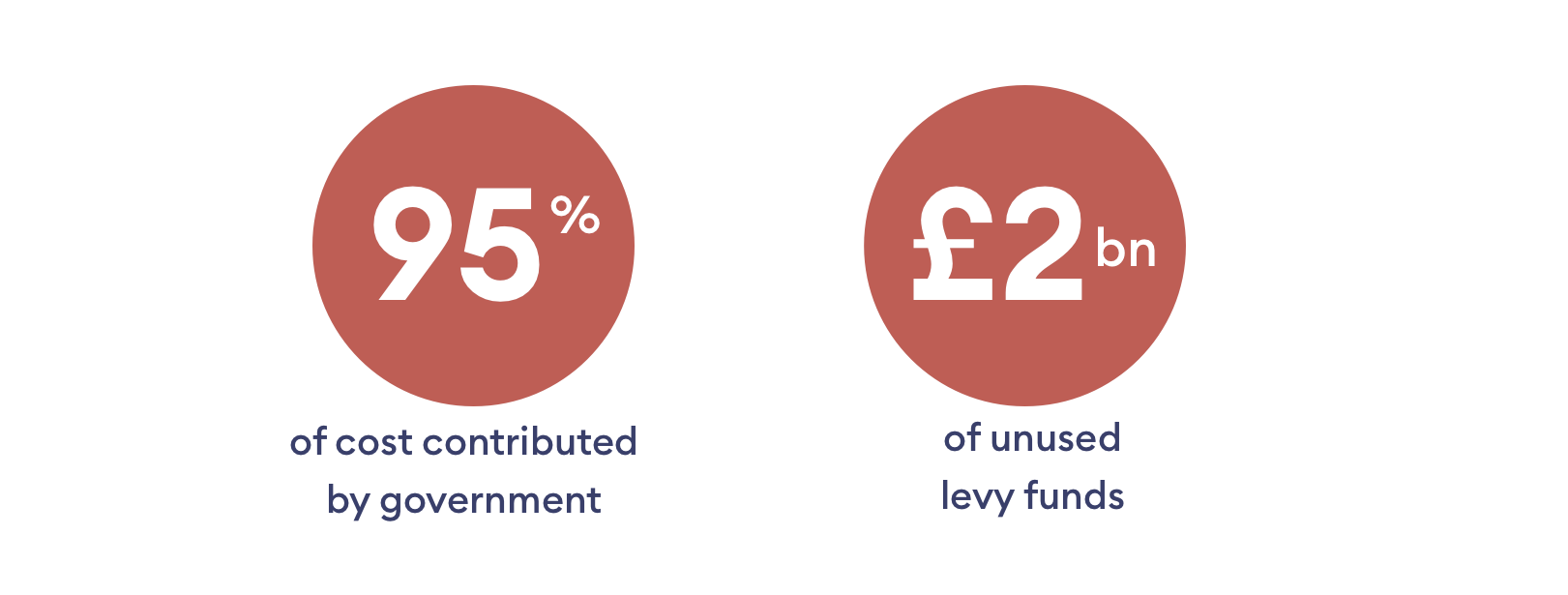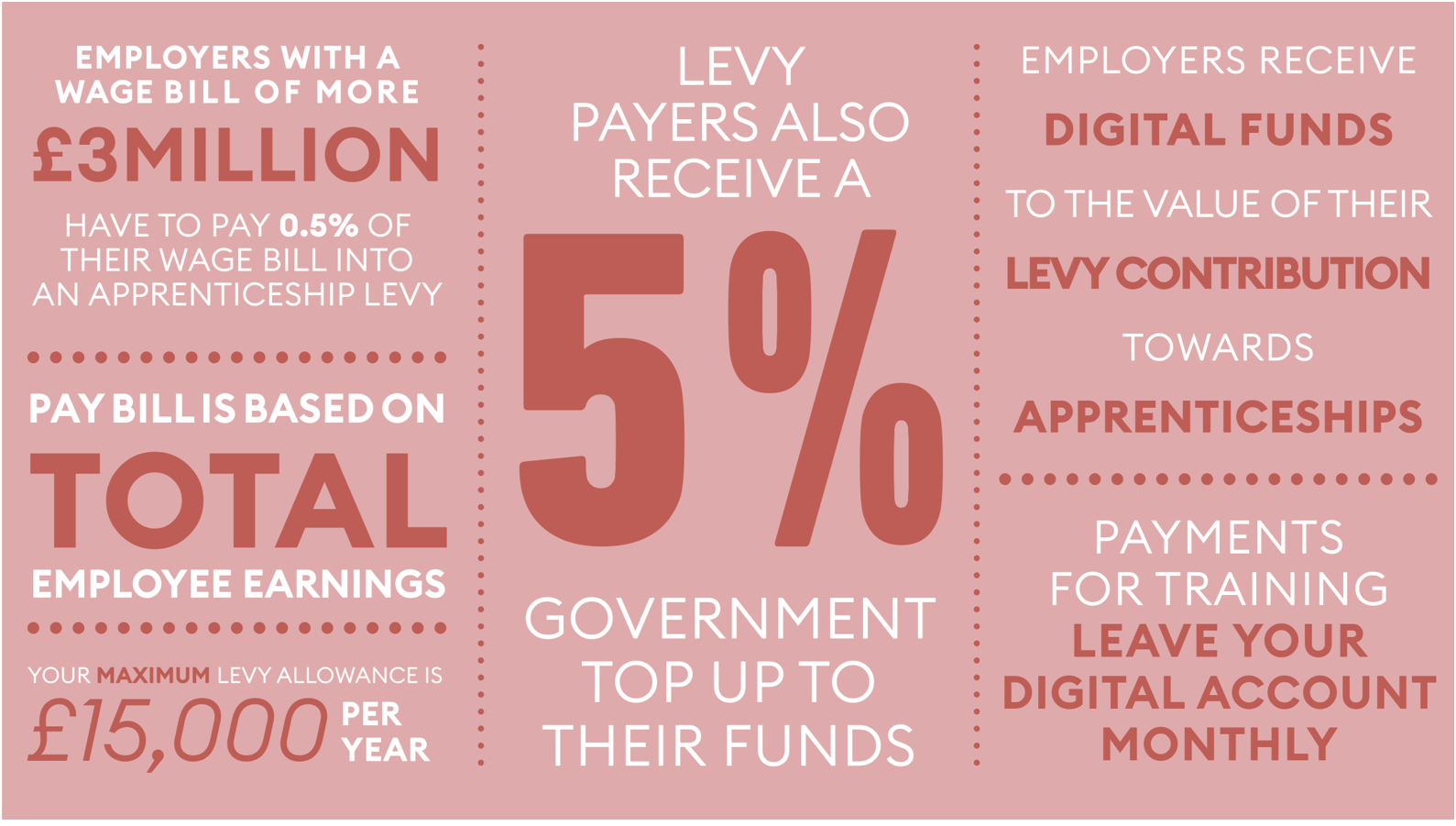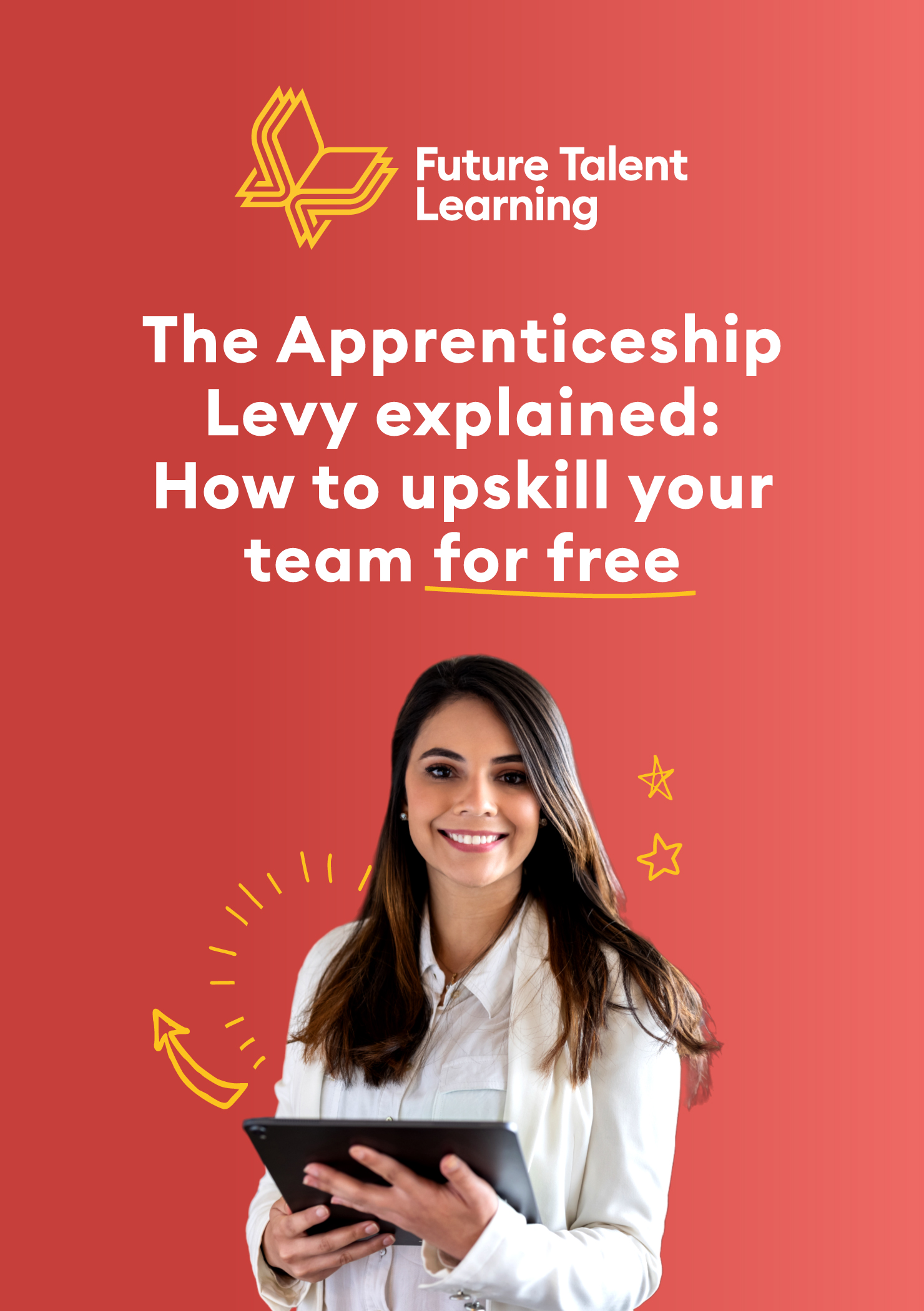The purpose and perception of apprenticeships have changed dramatically in recent years. What was once the preserve of school-leavers looking for technical training in industries such as construction and manufacturing has now morphed into training programmes that are applicable to all levels and sectors.
Put simply, modern-day apprenticeships are open to everybody. In fact, 47% of all apprenticeships started in 2019/20 were by people aged 25 or over, with a total of 719,000 people involved in apprenticeships, according to figures from the government.

One of the key reasons for the rise in apprenticeships is the Apprenticeship Levy. Launched in 2017, the levy requires all employers with a wage bill of more than £3m a year to pay 0.5% of their payroll each month as a tax. This can then be reinvested into the organisation’s workforce through apprenticeship training, providing valuable skills development and training.
Businesses with a wage bill below £3m are not required to pay the levy, but can provide apprenticeships for up to 10 employees, with the government contributing 95% of the cost.
However, many employers are failing to make use of potential levy funding and training. UK businesses have lost £2bn in unused Apprenticeship Levy funds since 2019, with many writing the levy off as a ‘tax’, according to the CIPD. Nevertheless, apprenticeships continue to be an important source of training and skills development for employers.
What happens to unspent levy funds? Employers get 2 years (24 months) to use their funds once they enter their Apprenticeship Service account, after which the funds will expire.
Because your funds will expire, it’s recommended that you invest in high-quality training and assessment. You can use any unspent levy funds in each financial year to support your existing apprentices to complete their training, or enable existing employees attend new apprenticeship courses.
You can also pay for apprenticeship training for smaller employers or make additional payments to support apprentices.
Apprenticeships are open to anyone aged 16 or over who is not in full-time education. It’s also important to note that apprenticeships – and the Apprenticeship Levy – can be used for existing employees as well as new hires. In fact, many businesses are now investing in apprenticeships to help existing employees gain industry-standard skills.
They also work for more senior employees. As we’ll see below, apprenticeships are split into levels, with the highest level being equivalent to a master’s degree. Many businesses are happy to help leaders train on MBA programmes, so why not modern-day apprenticeships?
For employers, apprenticeships are an excellent way of using government funding to upskill your employees through internationally recognised qualifications. If you are an Apprenticeship Levy payer, the funds in your account can be used for apprenticeship training to develop your talent base. If you do not pay the levy, the cost of an apprenticeship is shared between you and the government. You’ll pay 5% of any training costs up to the funding band maximum.
There are four main tiers of apprenticeship, depending on the level of expertise provided. These start at school-leaver level and go up to the equivalent of postgraduate education.

The level of apprenticeship someone chooses depends on a number of things. Firstly, the higher the apprenticeship level, the more likely you are to need more qualifications, such as A levels or foundation degrees. Higher level apprenticeships may also last longer (apprenticeships take between 1 and 4 years to complete), although this isn’t always the case. They may also lead to a professional qualification.
In 2020, the government moved apprenticeships from a framework model to a standards model, with the aim of improving on-the-job learning by tailoring apprenticeships more closely to individual job roles. This is good news for employers, with apprenticeships being more occupation focused and less qualification led. Standards are developed by employers with specific job role competencies as the focus.
An apprenticeship combines day-to-day work with off-the-job training and learning. Apprentices are employees who earn a wage and spend at least 20% of their time on study and training related to their job. However, it is up to the employer how this is structured. So, it may be that the employee spends 1 day a week at a training provider, or they may choose to block book time for certain training programmes or workshops.
The study element of apprenticeships depends on the training provider used. This can be a mixture of classroom-based learning, virtual and online training and face-to-face masterclasses or technical training. Training is often provided by technical colleges, private institutions and accredited bodies.
At the end of their training, the apprentice should be able to demonstrate they can perform tasks to industry standards and are fit for the job.
This focus on apprenticeships means that they are now an exciting option for both employer and employee when it comes to building new skills. They allow employers to upskill or reskill existing employees, create new workforce capabilities and even adapt training to the specific needs of their organisation.
Moreover, they improve employee engagement and wellbeing. According to the Apprenticeship Service, 86% of employers said apprenticeships helped them develop skills relevant to their organisation, 78% said apprenticeships improved their productivity and 74% said they improved the quality of their product.
>Before setting up an apprenticeship, there are some key responsibilities an employer has to meet.
It’s also important to think about setting up a development plan for your apprentices, while working in conjunction with your training provider. This can ensure that you tailor the skills your apprentice gains to both their personal needs and those of your business.
According to the World Economic Forum, 50% of all employees will need reskilling by 2025. The impact of technology on the world of work and ongoing challenges around COVID-19 mean that we’re entering a world where continuous learning will become inevitable.
Apprenticeships allow employers and employees to develop new skills in a way that is tailored towards individual jobs and individual companies. As advanced apprenticeships can be used for both new hires and existing employees, they are a great way to build new capability in your business.
Alongside this, the Apprenticeship Levy means that organisations can access government funding to support skills development. Levy-paying employers can use the funds in their account to pay for training and assessment, while non-levy-paying companies can share up to 95% of the cost of apprenticeships with the government. In effect, levy-funded courses allow organisations to develop their talent in an almost-free way.
This means that more and more organisations are looking to develop both existing and new staff through levy-funded apprenticeships. The question becomes more about the skills you want your people to develop and choosing the right training provider.

The first decision to make is which level is right for your employees. The level of apprenticeship you choose will depend on your learner’s experience. At Future Talent Learning, we offer both Level 3 and Level 5 apprenticeships in leadership development.
A Level 3 apprenticeship is aimed at graduates, new business entrants and new managers. The programme lasts 12 months and, on completion, learners gain a Level 3 Diploma in Team Leadership and Supervision – equivalent to an A level qualification.
Level 5 apprenticeships are aimed at experienced managers looking to develop their skills towards senior management and the c-suite. Learning here lasts 15 months and successful students will gain a Level 5 Diploma in Operations and Departmental Management.
Both programmes are structured to empower learners to develop the mindset, capabilities and experience to future-proof their skills and deliver long-term organisational transformation. Students will apply learnt skills to real-life business situations through simulations alongside coaching and curriculum learning.
However, consider the expertise and level of your employee before considering them for an apprenticeship. If the individual is a project manager, high-potential employee or supervisor, a Level 3 apprenticeship will suit their skill set best, preparing them both technically and emotionally for managing people.
If your colleague is a senior manager or team leader, consider a Level 5 apprenticeship. This is best placed to provide the learning needed to develop their leadership capabilities. This apprenticeship will give them curated, bite-sized content, a safe space to try out new behaviours and methods, and support in applying their learning at work.
Building a successful apprenticeship scheme should be part of a holistic workforce planning agenda. It should focus on skills development and form part of a long-term talent strategy.
This means that HR leaders need to provide clarity on the role apprentices play in the business, allowing for off site learning and supporting line managers to effectively manage workloads. The CIPD has set out guidelines for employers on creating effective apprenticeships in its Apprenticeships that work paper.
There are several ways to recruit apprentices, but the easiest starting point is through the government’s Apprenticeship Services site. Here, organisations can create an account that gives them access to apprenticeship funding and training providers, as well as advertising for and recruiting apprentices. Alternatively, you can look to hire apprentices through your normal recruitment routes.
Here are some key steps to follow if you want to hire an apprentice.
Using the government’s own Apprenticeship Service portal is the easiest way to manage your apprenticeship journey. You’ll be able to access apprenticeship funding, recruit apprentices and choose training providers applicable to advanced apprenticeships – all in one account.
Apprenticeships are designed by relevant groups of employers and supported by the Institute for Apprenticeships and Technical Education. You can browse relevant advanced apprenticeships on the Apprenticeship Service website, complete with information about how they will be assessed and where the qualification will take them.
Once you’ve decided on your apprenticeship, you then choose a training provider to deliver it. Talk to other organisations about the training providers they use, speak to technical colleges or simply browse the Apprenticeship Service portal for the best fit for your business.
An apprentice is a regular employee who is also undertaking training. An employer must provide a contract of employment, as they would with any other employee, alongside an apprenticeship agreement detailing the apprenticeship they are working towards, what they will qualify for and how much training they will be expected to do. You can see an example apprenticeship agreement here.
You’ll also need a commitment statement signed by your apprentice and training provider. This details how you, your apprentice and the training provider will work together to successfully complete the apprenticeship. It should include the plan of content, how it will be delivered and how you will resolve disputes. An example commitment statement is here.
Before hiring apprentices, you’ll need to work out your eligibility for funding. If your company wage bill exceeds £3m per year, you’ll already pay the Apprenticeship Levy and can use this towards the cost of your apprenticeship, alongside a 10% top-up from the government. If this doesn’t cover the costs, you’ll need to pay 5% of any outstanding balance, with the government covering the rest – up to the funding band maximum allocated to your chosen apprenticeship.
If you do not pay the levy, you’ll pay 5% of any training costs with the rest coming from the government – up to the funding band maximum.
Use the Apprenticeship Service to advertise your position and sift through potential candidates. Your training provider can also help with sourcing apprentices.

Rebecca Keeble, Talent Manager, Marks & Spencer
You get a good feeling when you come across something that you immediately know is a good fit for both your organisation and your people. At M&S, we’re 2 years into our Enterprise Graduate Programme, where graduates are offered an additional apprenticeship to build leadership skills. We’re still in the ‘shaping and moulding’ phase, and the engaging content, relevant skills areas and different format on offer with Future Talent Learning’s Transformational Leadership Programme meshed so well with the approach we’re taking and direction we’re going. It felt spot on for both the type and the level of audience we need to appeal to.
We started with a small pilot of graduates, but from day one we had eyes on what the bigger perspective could be and how this different type of programme – delivered virtually and with an experiential learning approach – could complement our overall learning proposition and unlock potential for so many colleagues. We were sitting on money in the Apprenticeship Levy that we could be doing more with, and here was something off-the-shelf but with a good ‘M&S feel’ – it just stood out as an obvious thing to do. I’m so impressed that the Apprenticeship Levy can fund such modern, engaging and relevant development for our people.
Previously, we’ve used our levy pot to support us with more technical or retail-based apprenticeships, but this is the first time we’ve ventured into a leadership space. It’s been brilliant to receive feedback from learners around the quality of content and speakers, and how they’ve been able to use what they’ve learnt immediately in their day jobs.
What stood out particularly for me was how closely the Transformational Leadership Programme modules aligned with the key skills we’re focused on developing internally. Through modules covering self-awareness and self-management, alongside those developing communication and decision-making, the all-important soft skills of problem-solving, teamwork, critical thinking and agility, among many others, are built and evolved. These are central to developing talent for today’s workplace.
I’m impressed with how Future Talent Learning’s approach is both relevant and innovative; how the online platform looks and the way learning happens through experience, gamification and virtual challenges is something I’ve not seen from other training providers. The fresh activity-led elements seen in the Transformational Leadership Programme make all the difference, particularly to graduates: they don’t want to be talked at; they want to take part and be involved from the outset.
It’s clear that Future Talent Learning has come at this from a learning perspective, not from a training perspective and a desire to build a one-size-fits-all programme. I can see expertise and depth in its development, and the positivity I feel is being reflected in excellent feedback from the graduate cohort. In particular, learners have described how well the content has been thought through from a virtual angle, using digital simulation to place participants in workplace scenarios and set challenges that develop both individual and team skills. In fact, I do believe it’s the fully virtual nature of the programme that makes the activities and experiences so innovative and engaging.
One learner was quite sceptical ahead of the time-management section in the self-management module. As someone who has a master’s degree and is respected as a high performer in their role, there was a concern they might simply be covering old ground. Conversely, the engaging session proved invaluable: they’re now using the new methods acquired through the programme and have completely changed how they work, managing time and themselves more efficiently.
It’s been brilliant to hear how a strong learning culture is developing, with apprentices keen to share their learning and help cement it while being able to positively influence people around them and improve efficiencies. Seeing this keenness to apply learning back in the business reinforces just how interesting and engaging participants are finding the programme – just as we’d expected.
Each module provides many stretch resources that make it easy for learners to go further and do extra reading, exploring a skills topic in greater detail, for example. This ticks the box for graduates, in particular, who will make time to prioritise their own development in this way.
Participants have talked about how effective the one-to-one coaching has been for them, in terms of both keeping to the programme deliverables and providing opportunities to share development with their line manager. Specifically, they highlighted the programme’s tripartite approach and how it provides a platform for hugely beneficial three-way coaching conversations between them, their manager and their coach. Through these conversations, they’ve felt able to clearly demonstrate the programme’s value to their role, particularly around the importance of time away from the job through the 20% off-the-job training model, and influencing their line manager of its worth.
We embarked on the Transformational Leadership Programme with an ambition to see our graduates become more effective in their role, whether through developing their soft skills, being more self-aware and agile, or growing their understanding of different business functions to give them a broader base to draw from as future leaders.
I can definitely say that our ambitions for this leadership apprenticeship are being realised and that by partnering with Future Talent Learning, we are successfully complementing our Future Leaders Graduate Programme.
While listening to a webinar the other day by another training provider, I was reminded why Future Talent Learning gives such a different offering and stands out in this leadership development space. Its programme is highly relevant for today’s business environment, designed to fully engage learners in a virtual setting and can be fully funded by the Apprenticeship Levy in England.
We’re delighted with how participants are developing and look forward to bringing through many more M&S cohorts.

Craig Smith, Head of Learning and Employee Experience, Babcock
The old adage of “people join organisations and leave leaders or managers” is very true. Leaders have the biggest impact on employees’ experience at work, so if you can invest time now in developing high-quality leadership capability and the types of leaders that you need and want in the future, you are ultimately future-proofing your business. Our employee engagement surveys had identified a need to improve leadership capability. We wanted to broaden out our group learning and development opportunities and make our leadership offering more consistent and scalable.
Having previously run a group MBA programme for a small cohort of senior executives, we wanted to democratise learning across the business and develop an offering that would be suitable and engaging for our future talent; those high-potential emerging leaders and managers who are willing to develop themselves, and who are prospective Babcock board members of the future.
With cost in mind, we were also keen to explore options which would allow us to adopt a blended commercial and global approach while also utilising our Apprenticeship Levy in England. My experience of many leadership programmes is the standard, formulaic apprenticeship-driven model. But we wanted something different; something which felt like a higher investment programme, rather than an apprenticeship that simply happened to cover ‘leadership’.
We definitely found what we were looking for with Future Talent Learning. Even after extensive research in the leadership apprenticeship market, we simply couldn’t find anything else like it to fit our brief. The programme offered truly relevant content, delivered in a style to engage learners in new and different ways, all while being virtual. I was hugely impressed with the quality of speakers, curriculum content and subject areas, one-to-one personalised coaching and the virtual simulations.
I was also struck by the delivery model. Too often, small cohorts of learners or even one-on-one programmes can be inefficient. Future Talent Learning has identified economies of scale and created a programme which makes it easy for us to upskill more people at the same time, using impressive technology and slick delivery methods.
The quality of the Future Talent Learning coaches has been a major feature of the programme. Every learner is supported throughout by inspiring individuals in a highly personalised way. As well as helping the learners to apply their learning, they are also empowering the learners at every turn to notice the progress that they are making.
The regular study groups facilitated by the coaches are also adding a surprising amount of interaction between the learners, even virtually. Being able to talk about and share their learning experiences, as well as to network with their peers on the programme, has had a very positive reinforcing effect.
I’ve been incredibly impressed by the inclusion of virtual action learning sets as a core part of the programme. We want all of our future leaders to be developing the capability to coach and mentor their colleagues, and it’s brilliant that they are getting the opportunity to learn how to become competent and confident coaches themselves.
The programme goes further than just helping learners develop their soft skills; it also gives them plenty of opportunity to apply their new skills and knowledge to real-life business problems from the outset. There’s a big focus on encouraging learners to take their development further by exploring the many stretch resources provided. All of this demonstrates the quality of development offered by Future Talent Learning and adds tangible value to our business, even before the apprenticeship is completed.
The interface with the Future Talent Learning team has been smooth – the team are responsive and a pleasure to work with. Ahead of each cohort’s journey, we run webinars for learners and their line managers. This brings the written material to life and generates such a positive reaction. From the application process through sign-up and onboarding, to their experience on each learning module, feedback has been overwhelmingly positive. Learners agree that the development is both supporting them in their current role and helping them prepare for their futures.
From the line manager perspective, there was some initial reticence around the 20% off-the-job training model, but this hasn’t presented any issues so far. Line managers are wholly supportive and believe the programme is absolutely the right thing to be doing. The organisation is desperate for something like this and people have been pleasantly surprised – it’s a much better, much more forward-thinking approach than people would have expected Babcock to take!
Because the programme is so different to anything we’ve done before it has certainly strengthened the relationship between group and sectors, helping to bring the L&D function together while building the group’s reputation.
Working with Future Talent Learning has been a fantastic way for us to roll out an extremely high-value leadership programme across the organisation. It feels world-class. We made the conscious decision that this would be more than just a UK or even England thing. It absolutely needed to be inclusive and we wanted it to become the approach we took to developing our high-potential emerging leaders. And being able to unlock some of the money we pay into the Apprenticeship Levy to really get maximum value for the organisation is a huge bonus.
This programme is about giving people the fundamentals of leadership so that whatever context they are operating in, now or in the future, they are equipped with the skills and mindset to be successful. Through Future Talent Learning, we are developing people who are self-aware, inquisitive, open to change and agile. This new approach to learning has become core to our emerging talent development strategy. Through it, we genuinely are future-proofing our people and, by doing so, we are future-proofing our organisation.
Our leadership and management courses and apprenticeships upskill graduates, aspiring managers and existing managers with the behaviours and mindset to future-proof themselves and your organisation.
We’ve reimagined apprenticeships to provide continuous virtual learning that’s practised and applied in the flow of work to embed the learning.
All of our programmes are designed with immersive virtual experiences, simulations and gamification, brilliant multimedia e-learning curriculum content and development coaching.
Learners develop and practise the vital core interpersonal and human skills to make sure that they continue to embrace the constant changes we see across our businesses.
We have courses for graduates, aspiring managers, middle managers and senior leaders.
Arrange a call to find out how to use the Apprenticeship Levy to upskill, reskill and retain your existing employees.
Want to read the full article at your leisure or share it with a colleague?
Enter your details and download.





Change Board Holdings Limited,
trading as Future Talent Learning,
Main Apprenticeship Training Provider
UKPRN 10084912